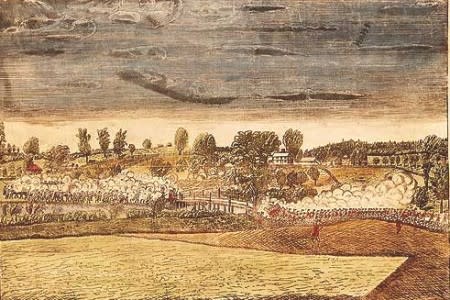Five myths about the start of the Revolutionary War
The American Revolutionary War started on April 19, 1775, at the towns of Lexington and Concord. But how accurate are some of the key facts that have been handed down to us through the generations?
We’ve done some historical sleuthing to find out what the real deal was with Paul Revere and the shot heard ‘round the world.
To set the scene: The Battles of Lexington and Concord in Massachusetts were the official start of hostilities between colonists who objected to British rule and British soldiers sent to restore order in the Colonies.
Not all colonists favored the Revolution and by some estimates, about 20 percent were Loyalists, while another 25 percent were mostly neutral.
But parts of New England were a hotbed of Patriot activity. British troops were garrisoned in Boston and their commander, General Thomas Gage, sent a force from Boston to seize military supplies stored by the Patriots in nearby Concord.
The rebel forces knew of the plans and were well-organized and armed. The British troops confronted one small group in Lexington, and for some reason, a shot rang out. The British opened fire upon the Patriots and then started a bayonet attack, killing eight local militia members.
The British ran into much stiffer resistance approaching Concord. Another shot rang out, and the British quickly found themselves outnumbered and outflanked by a combined force of Patriot minutemen and militia.
The British regulars then made a difficult retreat to Boston, which was greatly aided by the arrival of reinforcements led by Lord Percy. Today, we estimate that 49 Patriots and 73 British troops died in the fighting.
So let’s start with a few famous reports and quotes related to the first battle of the war.
1. Did Paul Revere really say, “The British are coming”?
That seems highly unlikely for several reasons. Revere was on a secret mission to warn the Patriots about the advance of British forces, and at the time, the colonists were British. His more likely response was, “The regulars are coming out.”
2. Did Revere ride by himself at midnight to warn the Patriots?
There were multiple riders as part of the intelligence effort set up by the Patriots. Two other men, William Dawes and Samuel Prescott, rode with Revere. In fact, Revere never reached Concord as part of the ride. He was detained by the British after leaving Lexington. It was Prescott who rode from Lexington to Concord.
3. Who shot the shot heard ’round the world?
In Ralph Waldo Emerson’s “Concord Hymn,” the “embattled farmers” fired “the shot heard ’round the world” at the British regulars in Concord. More likely, the shots were fired at Lexington, where the British fired on the Patriot militia, who also may have taken a few shots in the confusion.
One eyewitness to the skirmish was Paul Revere, who had been detained but not arrested by the British. He couldn’t tell who fired the first shot, in his account. Both sides later accused the other of firing first.
4. Were the colonists just a bunch of farmers fighting against the British?
In reality, the Patriots at Lexington and Concord were well organized and well supplied. Many were veterans of the French and Indian campaigns, and they better understood the battle tactics in the area than the British. After withdrawing back to Boston, Lord Percy said, “They have amongst them those who know very well what they are about, having been employed as rangers among the Indians.”
5. Did the Patriots engage the British from a distance using rifles?
The Colonists primarily used muskets, and not rifles, and had to get fairly close to the enemy in small-group formations to be effective.
An article on the American Rifleman website makes a convincing argument that the Patriots were better shots than the British, but only 2 percent of their shots were on target.
Much of the fighting in the British retreat was in hand-to-hand combat, and the British were able to use bayonets. The Patriots used circling tactics to constantly harass the British while building up their own troop strength. In the end, about 15,000 Patriot militia and Minutemen surrounded Boston as they trailed the British retreat.
Recent Stories on Constitution Daily
The seeds of Revolution: The Stamp Act protests in Boston
Forgotten facts about George Washington’s private life
A salute to the four Founding Fathers born in Ireland
It was 226 years ago today: George Washington becomes President


